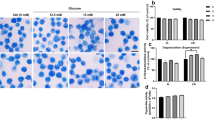Abstract
Human neutrophils, having been activated by the chemotactic peptide N-formylmethionyl-leucyl-phenylalanine (FMLP), evoke histamine release from rat serosal mast cells. The release is dependent on FMLP concentration and it can be inhibited by disodium cromoglycate and by a flavonoid, silymarin, which displays free radical scavenging properties. Silymarin inhibition of neutrophil-mediated histamine release is dose-dependent. These results further stress the concept of a neutrophil-mast cell interaction, which may be involved in inflammatory processes.
Similar content being viewed by others
References
N.S. Ranadive andC.G. Cochrane,Mechanism of histamine release from mast cells by cationic protein (band 2) from neutrophil lysosomes, J. Immun.106, 506–516 (1971).
H. Ohmori, K. Komoriya, A. Azuma, S. Kurozumi andY. Hashi Oto,Xanthine oxidase-induced histamine release from isolated rat peritoneal mast cells: involvement of hydrogen peroxide, Biochem. Pharmac.28, 333–334 (1979).
W.R. Henderson, E.Y. Chi andS.J. Klebanoff,Eosinophil peroxidase-induced mast cell secretion, J. Exp. Med.152, 265–279 (1980).
O. Stendahl, L. Molin andM. Lindroth,Granulocyte-mediated release of histamine from mast cells, Int. Archs Allergy appl. Immun.70, 277–284 (1983).
B.I. Coble, M. Lindroth, L. Molin andO. Stendahl,Histamine release from mast cells during phagocytosis and interaction with activated neutrophils, Int. Archs Allergy appl. Immun.75, 32–37 (1984).
R. Fantozzi, S. Brunelleschi, L. Giuliattini, P. Blandina, E. Masini, G. Cavallo andP.F. Mannaioni,Mast cell and neutrophil interactions: a role for superoxide anion and histamine, Agents and Actions16, 260–264 (1985).
R. Fantozzi, S. Brunelleschi, G. Banchelli Soldaini, P. Blandina, E. Masini, L. Raimondi andP.F. Mannaioni,N-Formylmethionyl-leucyl-phenylalanine: different releasing effects on human neutrophils and rat mast cells, Agents and Actions13, 218–221 (1983).
D. Lorenz, P.W. Lücker, W.H. Mennicke andN. Wetzelsberger,Pharmacokinetic studies with silymarin in human serum and bile, Meth. and Find. Exptl. Clin. Pharmacol.6, 655–661 (1984).
A. Bindoli, L. Cavallini andN. Siliprandi, On the mechanism of antiperoxidative action of silymarin on biological membranes. In:Interdisciplinary trends in surgery (Xth Congress of the European Federation of the International College of Surgeons, Milan, 26–29 June 1977), pp. 813–818. Edizioni Minerva Medica, Torino 1979.
J.P. Bennett, B.D. Gomperts andE. Wollenweber,Inhibitory effects of natural flavonoids on secretion from mast cells and neutrophils, Arzneim.-Forsch./Drug Res.31, 433–437 (1981).
Author information
Authors and Affiliations
Rights and permissions
About this article
Cite this article
Fantozzi, R., Brunelleschi, S., Rubino, A. et al. FMLP-activated neutrophils evoke histamine release from mast cells. Agents and Actions 18, 155–158 (1986). https://doi.org/10.1007/BF01988009
Issue Date:
DOI: https://doi.org/10.1007/BF01988009




